Based on Your Reading:
Get Your Free Mesothelioma Guide

Find a Top Mesothelioma Doctor

Access Help Paying for Treatment

Asbestos was used to manufacture electrical panels and other electrical components, including wire insulation, cable wrap and electrical paper. The wiring of electrical boards and panels contained asbestos to reduce the risk of fire, but it put the health of electricians at risk.
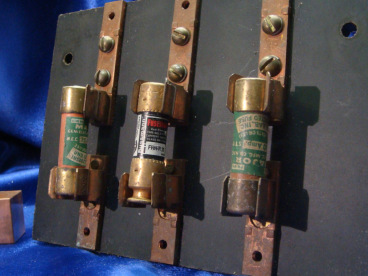
Written by Michelle Whitmer • Edited By Walter Pacheco • Scientifically Reviewed By Sean Fitzgerald, PG
The Mesothelioma Center at Asbestos.com has provided patients and their loved ones the most updated and reliable information on mesothelioma and asbestos exposure since 2006.
Our team of Patient Advocates includes a medical doctor, a registered nurse, health services administrators, veterans, VA-accredited Claims Agents, an oncology patient navigator and hospice care expert. Their combined expertise means we help any mesothelioma patient or loved one through every step of their cancer journey.
More than 30 contributors, including mesothelioma doctors, survivors, health care professionals and other experts, have peer-reviewed our website and written unique research-driven articles to ensure you get the highest-quality medical and health information.
My family has only the highest compliment for the assistance and support that we received from The Mesothelioma Center. This is a staff of compassionate and knowledgeable individuals who respect what your family is experiencing and who go the extra mile to make an unfortunate diagnosis less stressful. Information and assistance were provided by The Mesothelioma Center at no cost to our family.LashawnMesothelioma patient’s daughter


Whitmer, M. (2024, March 25). Asbestos in Electrical Wiring. Asbestos.com. Retrieved April 18, 2024, from https://www.asbestos.com/products/electrical-panel-partition/
Whitmer, Michelle. "Asbestos in Electrical Wiring." Asbestos.com, 25 Mar 2024, https://www.asbestos.com/products/electrical-panel-partition/.
Whitmer, Michelle. "Asbestos in Electrical Wiring." Asbestos.com. Last modified March 25, 2024. https://www.asbestos.com/products/electrical-panel-partition/.
From the earliest days of commercial electricity, manufacturers used asbestos in various components for electrical panels. Asbestos protected building tenants from fire and electrocution but also exposed electricians and other workers to severe health risks.
The electricity for a building is received and distributed through a device called an electrical panel or distribution box. Electrical current produces heat, and if not grounded properly, it can arc and cause a fire or electrocution injury. In the early 1900s, as electricity became popular in the United States, manufacturers sought materials that could make electrical supply and distribution systems safer.
Asbestos use became a favored solution thanks to the fibrous mineral’s resistance to heat and electricity, low cost and the ease with which manufacturers could mix it into cement, millboard, plastic, cloth and paper. Though company executives knew of the harmful effects of inhaling asbestos dust as far back as the 1930s and 1940s, the link between asbestos exposure and diseases, such as asbestosis and mesothelioma, was not made public until the 1970s and 1980s.
Ebonized Asbestos Panels
“Asbestos lumber” was a type of easily workable asbestos-containing cement marketed as a fireproof alternative to wood boards. “Ebonized” asbestos lumber was treated with a special compound to make it resistant to moisture as well.
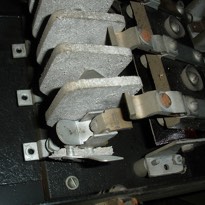
Asbestos Cement Electrical Shielding
Simple sheets of asbestos cement could be placed in between electrical components as shielding. Asbestos cement could also be formed into arc chutes that completely enclosed switch equipment.
Molded Asbestos Cement Bases
Manufacturers often shaped asbestos cement to fit specific electrical components. This removed the need to install extra parts for shielding.
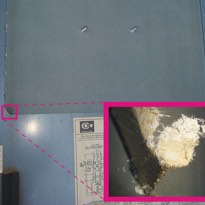
Asbestos Electrical Paper
Pieces of asbestos insulation paper, also known as flash guards, were used to line the inside of many electrical boxes. Asbestos paper products are highly vulnerable to wear and tear, creating a higher asbestos exposure risk.
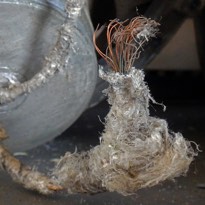
Asbestos Wire Insulation
Asbestos was used to fireproof and insulate individual wires. Fraying asbestos wiring can easily release dangerous asbestos fibers.
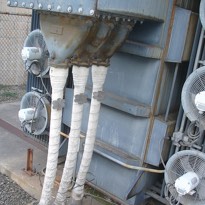
Asbestos Cable Wrap
Like pipes, thick electrical cables were sometimes wrapped in asbestos paper or cloth, which can degrade and crumble over time. Many electrical components were also made of molded asbestos plastic.
Get Your Free Mesothelioma Guide

Find a Top Mesothelioma Doctor

Access Help Paying for Treatment

Popular asbestos-containing electrical panel and wire insulation brands include:
| Manufacturer | Brand |
|---|---|
| General Electric | Deltabeston wires |
| Johns Manville | Ebony electric board, Electrobestos, Trancell, Vulcabestos |
| Siemens Energy & Automation | Bulldog, Murray |
| Turner & Newall | Sindanyo asbestos board |
| Union Carbide Corporation | Bakelite Panels |
Other manufacturers of these products include:
In factories that produced asbestos panel compounds, workers added raw asbestos fibers to tar, cement, millboard and other materials, creating high levels of toxic dust in the air. The amount of asbestos in mixtures varied. The finished products pose a threat to construction workers, electricians, homeowners and demolition crews, because sawing, drilling, sanding or breaking electrical panels can release asbestos fibers.
Simply replacing a blown fuse on an older electrical supply system can put electricians and those in other occupations in contact with crumbling asbestos materials. Do-it-yourselfers working on electrical panels in older homes also face the risk of exposure.
Microscopic asbestos dust has no scent, and it can easily contaminate workers’ clothing and lodge in people’s lungs permanently, causing cellular damage over time. A 2022 health report noted that asbestos electrical tapes and resin could also produce dust.
Asbestos in electrical wiring and panels is known to cause the following diseases:
If you’ve been diagnosed with an asbestos-related disease it is important to get medical advice from a doctor who specializes in your diagnosis. Seeking treatment from an expert may improve your chances of long-term survival.

Electricians and other tradesmen have filed many legal claims against asbestos electrical panel manufacturers after developing serious illnesses such as lung cancer and mesothelioma. Both Westinghouse and General Electric have lost many workers’ compensation cases based on occupational asbestos exposure, and victims have received compensation through personal injury lawsuits and wrongful death lawsuits as well.
In many cases, mesothelioma compensation options are available through special trust funds for asbestos-related claims. Johns Manville set up the first asbestos personal injury settlement trust in 1988, setting a precedent in bankruptcy law many other former asbestos companies have followed in the years since.
An experienced mesothelioma attorney can review your case to determine whether you qualify to file a lawsuit and multiple trust fund claims. Other forms of compensation include VA claims, workers’ compensation, Social Security Disability, and treatment and travel grants.
Typical asbestos abatement procedures require wetting dangerous areas to prevent fibers from becoming airborne, but this may not be an option with electrical systems. To prevent electrical hazards from supply systems, licensed abatement workers must either use a dry technique with high-efficiency particulate air ventilation or ensure connectors are disconnected or shut off.
Dry asbestos abatement procedures in facilities require special approval from the U.S. Environmental Protection Agency, so it is important to hire a licensed professional to abate asbestos electrical panels. This regulation does not apply to homes and residences with four or fewer dwellings in the structure, but it does apply to any institutional, commercial, industrial and public building, including residential buildings with five or more dwellings.
After successful personal injury lawsuits in the 1970s and 1980s revealed the deadly consequences of asbestos exposure, electrical panel manufacturers began to replace the asbestos in their products with substitutes such as gypsum, calcium silicate, expanded perlite, cellulose and polystyrene.
By the 1940s, when electricity had found its way into most American towns and cities, many businesses, such as the Johns Manville Corporation, had already made a fortune off asbestos-containing cement and thermal insulation. Johns Manville incorporated asbestos into electrical panels and other electrical parts. In addition to Johns Manville, the growing electrical insulation industry included other companies that used asbestos such as Westinghouse Electric and Detroit Fuse and Manufacturing Company.
Your web browser is no longer supported by Microsoft. Update your browser for more security, speed and compatibility.
If you are looking for mesothelioma support, please contact our Patient Advocates at (855) 404-4592
